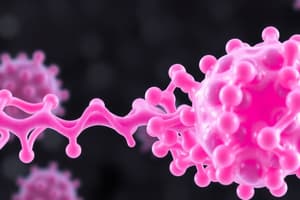Podcast
Questions and Answers
What is the primary function of chylomicrons in the body?
What is the primary function of chylomicrons in the body?
- Act as enzyme inhibitors in lipid metabolism
- Regulate cholesterol levels in the blood
- Transport dietary lipids from the intestine to peripheral tissues (correct)
- Transport endogenously synthesized lipids from the liver
Which apolipoprotein is responsible for activating lecithin: cholesterol acyltransferase (LCAT)?
Which apolipoprotein is responsible for activating lecithin: cholesterol acyltransferase (LCAT)?
- Apo E
- Apo A-I (correct)
- Apo C-II
- Apo B-100
What happens to intermediate density lipoproteins (IDL) after their formation?
What happens to intermediate density lipoproteins (IDL) after their formation?
- They promote the synthesis of new chylomicrons
- They are directly excreted by the kidneys
- They increase triacylglycerol content
- They are converted to low-density lipoproteins (LDL) (correct)
What is the approximate half-life of chylomicrons in the bloodstream?
What is the approximate half-life of chylomicrons in the bloodstream?
Which apolipoprotein is known to inhibit lipoprotein lipase activity?
Which apolipoprotein is known to inhibit lipoprotein lipase activity?
What is the primary function of apolipoproteins in lipoproteins?
What is the primary function of apolipoproteins in lipoproteins?
Which type of lipoprotein has the highest percentage of protein?
Which type of lipoprotein has the highest percentage of protein?
Which lipid is predominant in low-density lipoproteins (LDL)?
Which lipid is predominant in low-density lipoproteins (LDL)?
How are lipoproteins primarily classified?
How are lipoproteins primarily classified?
Which lipoprotein is synthesized in the liver and competes with plasminogen?
Which lipoprotein is synthesized in the liver and competes with plasminogen?
Which apo-lipoprotein is found only in chylomicrons?
Which apo-lipoprotein is found only in chylomicrons?
Which method is NOT used to separate lipoproteins?
Which method is NOT used to separate lipoproteins?
What is the primary lipid component in chylomicrons?
What is the primary lipid component in chylomicrons?
Flashcards
Apolipoprotein
Apolipoprotein
A protein that helps regulate the uptake of lipids in tissues by interacting with lipoprotein receptors. Examples include apo B-100, apo E, and apo A-I.
Chylomicron
Chylomicron
A lipoprotein that carries dietary lipids from the small intestine to the tissues.
Lipoprotein lipase (LpL)
Lipoprotein lipase (LpL)
An enzyme that breaks down triacylglycerol in chylomicrons and very low-density lipoproteins (VLDL).
Lecithin:cholesterol acyltransferase (LCAT)
Lecithin:cholesterol acyltransferase (LCAT)
Signup and view all the flashcards
Intermediate-density lipoprotein (IDL)
Intermediate-density lipoprotein (IDL)
Signup and view all the flashcards
Lipoproteins
Lipoproteins
Signup and view all the flashcards
Very low-density lipoprotein (VLDL)
Very low-density lipoprotein (VLDL)
Signup and view all the flashcards
High-density lipoprotein (HDL)
High-density lipoprotein (HDL)
Signup and view all the flashcards
Low-density lipoprotein (LDL)
Low-density lipoprotein (LDL)
Signup and view all the flashcards
Lipoprotein(a) [Lpa]
Lipoprotein(a) [Lpa]
Signup and view all the flashcards
Lipid transport
Lipid transport
Signup and view all the flashcards
Study Notes
Lipid Transport
- Lipids are insoluble in water, associating with proteins to form lipoproteins, which are water-soluble.
- The protein portion of lipoproteins is called apolipoprotein.
- Lipoproteins transport lipids between various tissues.
- Total plasma lipid is 400-600 mg/dL, comprising triacylglycerol (20%), phospholipids (30%), cholesterol (40%), and free fatty acids.
Lipoprotein Structure
- Lipoproteins consist of a core of nonpolar lipids (triacylglycerol and cholesterol esters) and a surface layer of phospholipids and cholesterol.
- A portion of the lipoprotein is composed of apolipoproteins (apoproteins, or Apo).
- Apolipoproteins range from 1% in chylomicrons to 60% in some high-density lipoproteins (HDLs).
- Some apolipoproteins, exist as integral structural elements, while others as peripheral elements.
Lipoprotein Classification
- Lipoprotein density increases with the protein content.
- Lipoproteins are categorized by their density using ultracentrifugation and electrophoresis.
- Chylomicrons
- Very low-density lipoproteins (VLDL or pre-β-lipoprotein)
- Intermediate-density lipoproteins (IDL)
- Low-density lipoproteins (LDL or β-lipoprotein)
- High-density lipoproteins (HDL or α-lipoprotein)
- Lipoprotein (a) (Lp(a)) has a similar lipid composition to LDL. It competes with plasminogen for tissue plasminogen receptors.
- The predominant lipid in chylomicrons and VLDL is triacylglycerol (TAG).
- The predominant lipid in LDL is cholesterol.
- The predominant lipid in HDL is phospholipid.
Apolipoproteins
- Apolipoproteins are proteins associated with lipoproteins.
- Five major classes: A to E.
- Apo B is found in two forms: apo B-100 and apo B-48.
- Apo B-100 is present in LDL.
- Apo B-48 is found in chylomicrons.
- Apo (a) is present in Lp(a) and contains high carbohydrate content.
Apolipoprotein functions
- Promotes the solubility of lipids in plasma.
- Enhances the stability of lipoprotein particles.
- Acts as ligands for interactions with lipoprotein receptors on tissues, regulating tissue uptake of lipids.
Apolipoproteins as enzyme activators or inhibitors
- Some apolipoproteins act as enzyme activators or inhibitors.
- Activators:
- C-II for lipoprotein lipase.
- A-I for lecithin:cholesterol acyltransferase (LCAT).
- Inhibitors:
- ApoA-II and apoC-III for lipoprotein lipase.
- apoC-I for cholesteryl ester transfer protein.
- Activators:
Chylomicron Metabolism
- Site of synthesis: Intestinal mucosa.
- Function: Transports dietary lipids from the intestine to peripheral tissues.
- Structure: Primarily triacylglycerol (98%), with 1-2% proteins (apo B-48, E, and C-II)
- Half-life: Approximately 1 hour.
Very Low-Density Lipoprotein (VLDL) Metabolism
- Site of synthesis: Liver
- Function: Transports endogenously synthesized lipids from the liver to peripheral tissues.
- Structure: Primarily triacylglycerol, with 10% proteins (apo B-100, E, and C-II)
- Half-life: 1-3 hours.
Intermediate-Density Lipoprotein (IDL) Formation
- Lipoprotein lipase (LpL) action leads to TAG loss, resulting in VLDL remnants.
- These remnants are known as intermediate-density lipoproteins (IDL).
- IDL contains decreased TAG and increased cholesterol.
- IDL is either taken up by the liver or converted to low-density lipoproteins (LDL).
Studying That Suits You
Use AI to generate personalized quizzes and flashcards to suit your learning preferences.



